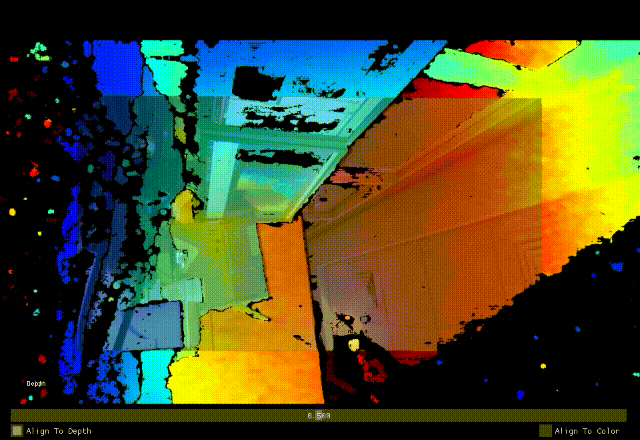rs-align
Overview
This example introduces the concept of spatial stream alignment.
For example usecase of alignment, please check out align-advanced and measure demos.
The need for spatial alignment (from here "align") arises from the fact
that not all camera streams are captured from a single viewport.
Align process lets the user translate images from one viewport to another.
That said, results of align are synthetic streams, and suffer from several artifacts:
- Sampling - mapping stream to a different viewport will modify the resolution of the frame to match the resolution of target viewport. This will either cause downsampling or upsampling via interpolation. The interpolation used needs to be of type Nearest Neighbor to avoid introducing non-existing values.
- Occlussion - Some pixels in the resulting image correspond to 3D coordinates that the original sensor did not see, because these 3D points were occluded in the original viewport. Such pixels may hold invalid texture values.
Expected Output
The application should open a window and display video stream from the color camera overlayed on top of depth stream data.
The slider in bottom of the window control the transparancy of the overlayed stream.
Checkboxes below allow toggling between depth to color vs color to depth alignment.

Code Overview
This example is using standard librealsense API and IMGUI library for simple UI rendering:
#include <librealsense2/rs.hpp>
#include "../example.hpp"
#include "imgui.h"
#include "imgui_impl_glfw.h"
In this example we are interested in RS2_STREAM_DEPTH and RS2_STREAM_COLOR streams:
// Create a pipeline to easily configure and start the camera
rs2::pipeline pipe;
rs2::config cfg;
cfg.enable_stream(RS2_STREAM_DEPTH);
cfg.enable_stream(RS2_STREAM_COLOR);
pipe.start(cfg);
SDK class responsible for stream alignment is called rs2::align. The user initializes it with desired target stream and applies it to framesets via process method.
// Define two align objects. One will be used to align
// to depth viewport and the other to color.
// Creating align object is an expensive operation
// that should not be performed in the main loop
rs2::align align_to_depth(RS2_STREAM_DEPTH);
rs2::align align_to_color(RS2_STREAM_COLOR);
// ...
frameset = align_to_depth.process(frameset);
Next, we render the two stream overlayed on top of each other using OpenGL blending feature:
glEnable(GL_BLEND);
// Use the Alpha channel for blending
glBlendFunc(GL_SRC_ALPHA, GL_ONE_MINUS_SRC_ALPHA);
if (dir == direction::to_depth)
{
// When aligning to depth, first render depth image
// and then overlay color on top with transparancy
depth_image.render(colorized_depth, { 0, 0, app.width(), app.height() });
color_image.render(color, { 0, 0, app.width(), app.height() }, alpha);
}
else
{
// When aligning to color, first render color image
// and then overlay depth image on top
color_image.render(color, { 0, 0, app.width(), app.height() });
depth_image.render(colorized_depth, { 0, 0, app.width(), app.height() }, 1 - alpha);
}
glColor4f(1.f, 1.f, 1.f, 1.f);
glDisable(GL_BLEND);
IMGUI is used to render the slider and two checkboxes:
// Render the UI:
ImGui_ImplGlfw_NewFrame(1);
render_slider({ 15.f, app.height() - 60, app.width() - 30, app.height() }, &alpha, &dir);
ImGui::Render();
Updated about 6 years ago
